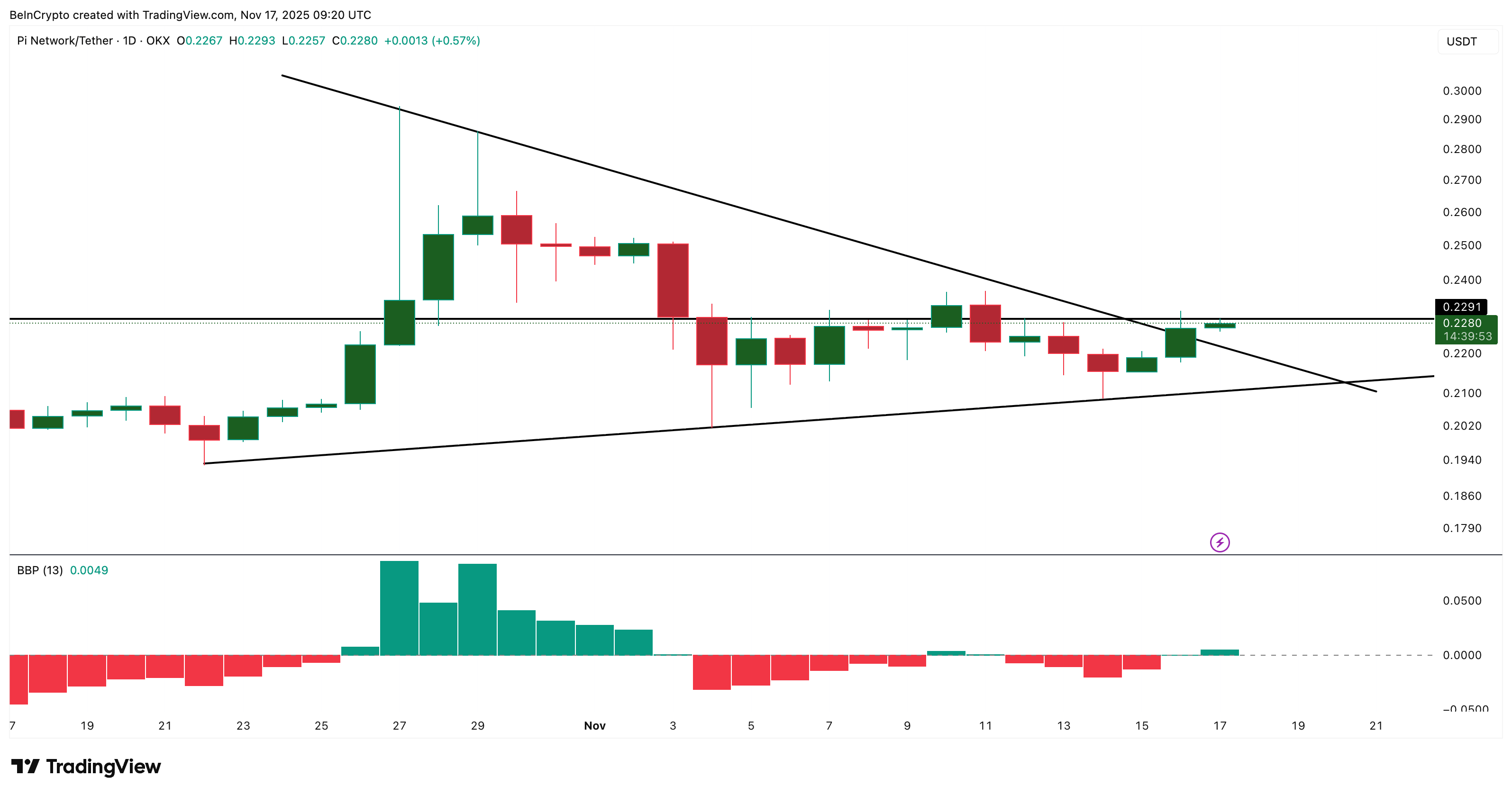Why Pi Coin’s Failed Breakout Isn’t the End of Its Month-Long Rally?
The Pi Coin price couldn’t clear a key resistance, but the rally isn’t finished. A near-complete EMA crossover, strong bull-bear pressure, and a supportive money-flow structure show why another breakout attempt may still form.
Pi Coin has been one of the more resilient tokens this month. While the broader market slipped 1.1% today, Pi Coin price still gained 0.8% and is up 11.5% over the past month. Keeping PI’s price history in mind, the 11.5% move isn’t anything less than a rally.
It recently failed a breakout that could have taken it higher, but the trend hasn’t flipped bearish. Several early signs show buyers still holding control, and the rally may not be done yet.
Early Trend Still Points To A Price Rebound
Pi Coin’s first bullish signal comes from the 4-hour chart, which helps spot early trend changes. On this timeframe, the 20-period EMA is closing in on the 50-period EMA. An EMA (Exponential Moving Average) tracks price over time with more weight on recent candles. A bullish crossover happens when the short-term EMA moves above the long-term EMA, often marking a momentum shift.
 Pi Coin Eyes A Bullish Crossover:
TradingView
Pi Coin Eyes A Bullish Crossover:
TradingView
Want more token insights like this? Sign up for Editor Harsh Notariya’s Daily Crypto Newsletter.
A similar crossover attempt happened on November 11, but sellers stepped in before the lines crossed, forcing the move to fail. If bulls hold price steady this time, the crossover could complete and give Pi Coin its next push.
On the daily chart, the Bull-Bear Power indicator supports this idea. The indicator tracks the gap between buying pressure and selling pressure. Despite the failed breakout at $0.229, Bull-Bear Power has flipped firmly into bullish territory, showing buyers are still in control.
 Bulls Are Still In Control Despite The Failed Breakout:
TradingView
Bulls Are Still In Control Despite The Failed Breakout:
TradingView
If this strength continues, the EMA crossover is less likely to fail like it did on November 11.
Pi Coin Price Action And Money Flow Hold The Key
The Pi Coin price continues to struggle with $0.229, which has rejected every breakout attempt so far in the near-term. If a daily close forms above this level, the next target becomes $0.236 (another strong resistance), followed by a possible move toward $0.266, the upper resistance zone.
The failed breakout earlier this week lined up with a drop in Chaikin Money Flow (CMF). CMF measures whether big wallets are adding or removing capital. Pi Coin saw inflows between November 15–16, but money quickly exited afterward, falling back toward the trendline.
 Pi Coin Price Analysis:
TradingView
Pi Coin Price Analysis:
TradingView
As long as CMF stays above its rising trendline, buyers still have a path to regain control. A break back above the zero line would confirm big money returning, strengthening the bullish case and supporting the EMA crossover from the 4-hour chart.
If CMF falls under the trendline, the downside opens up. In that case, Pi Coin could revisit $0.201, and under deeper market stress, even lower levels.
For now, Pi Coin needs only a 0.48% push to close above $0.229. If the crossover completes and CMF turns back up, Pi Coin may finally clear this barrier and extend its month-long rally.
Disclaimer: The content of this article solely reflects the author's opinion and does not represent the platform in any capacity. This article is not intended to serve as a reference for making investment decisions.
You may also like
Bolivia Turns to Stablecoins to Address Inflation and Currency Instability
- Bolivia legalizes stablecoin integration into banking , allowing crypto-based accounts and loans to combat inflation and currency devaluation. - Crypto transaction volumes surged 530% in 2025, driven by $15B in stablecoin use as businesses adopt USDT for cross-border payments. - Policy mirrors regional trends, with stablecoins recognized as legal tender to stabilize the boliviano amid 22% annual inflation and dollar shortages. - Challenges include AML safeguards, tax frameworks, and public trust, as regu

Bitcoin Updates: Bitcoin's Decline Sparks Altcoin Battle: ADA's $0.43 Support Faces Pressure
- ADA holds $0.43 support as Bitcoin’s seven-month low of $80,000 pressures altcoin market volatility. - Altcoin fragility stems from Fed’s high-rate signals, reduced institutional inflows, and technical breakdowns in key resistance levels. - Bitcoin’s $90,000 support breach triggered cascading liquidations, while ADA’s $0.43 level shows increased on-chain accumulation. - Infrastructure innovations like GeekStake’s staking protocol aim to stabilize networks during volatility without price forecasts. - Mark

Bolivia’s Digital Currency Bet: Navigating Volatility with Stable Solutions
- Bolivia's government permits banks to custody cryptocurrencies and offer crypto-based services, reversing a 2020 ban to combat inflation and dollar shortages. - Stablecoin transactions surged 530% in 2025, with $14.8B processed as Bolivians use USDT to hedge against boliviano depreciation (22% annual inflation). - State-owned YPFB and automakers like Toyota now accept crypto payments, while Banco Bisa launches stablecoin custody to expand financial inclusion for unbanked populations. - The policy faces c

Switzerland's Postponement of Crypto Tax Highlights Worldwide Regulatory Stalemate
- Switzerland delays crypto tax data sharing until 2027 due to ongoing political negotiations over OECD CARF partner jurisdictions. - Revised rules require crypto providers to register and report client data by 2026, but cross-border data exchange remains inactive until 2027. - Global alignment challenges exclude major economies like the U.S., China, and Saudi Arabia from initial data-sharing agreements. - Domestic legal framework passed in 2025, but partner jurisdiction negotiations delay implementation u

